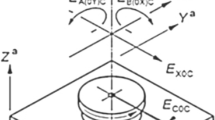Abstract
Today’s machine tools are highly complex mechatronic systems capable to exert large translational and rotatory movements. In most cases rolling bearings are used to connect the moving parts to each other. As full FE models of rolling bearings can consume a large amount of degrees of freedom (DOF) efficient methods for reducing the DOF consuming rolling elements to more simple equivalent models are needed. As an example a linear guide system is used. A special feature of the considered linear guide is that the runner block consists of three separate parts, which are hold together only by pretension and friction. FE simulations of such linear guide system were not reported before in the literature. Beside the full FE model three equivalent contact models are presented. The first two equivalent contact models feature novel characteristics. Advantages and disadvantages of the equivalent models are discussed using as reference a slice of the full model and simulation results of static stiffness. The validation of the numerical models is also done using the general analytical solution of Hertz.











Similar content being viewed by others
References
Lorenzer T (2009) Effiziente simulation rekonfigurierbarer Werkzeugmaschinen durch Verwendung vordefinierter Strukturmodule. symposium simulation von Werkzeugmaschinen, ETH Zürich, 2009
Dadalau A, Wosnik M, Croon N, Wadehn W, Verl A (2008) Steigerung der Effizienz bei der Modellierung und Simulation von komplexen FE-Modellen. ABS Treffen Stuttgart, 19–20 Juni 2008. Aachen: VDI Verlag GmbH, 2008 (Fortschritt-Berichte VDI, Fertigungstechnik, Nr.668), 2008
ANSYS Inc. (2010) Documentation for ANSYS, v13, 2010
Petuelli G (1984) Theoretische und experimentelle Bestimmung der Steifigkeits und Dämpfungseigenschaften normalbelasteter Fugestellen. Dissertation RWTH Aachen, 1984
Gonzalez-Valadeza M, Baltazar A, Dwyer-Joyce RS (2010) Study of interfacial stiffness ratio of a rough surface in contact using a spring model. Wear 268:373–379
Timoshenko S, Goodier JN (1951) Theory of elasticity. McGraw-Hill Book Company, New York
Landau LD, Lifshits EM (1959) Theory of elasticity. Pergamon Press, London
Brändlein J, Eschmann et al (1995) Die Wälzlagerpraxis. In: Vereinigte Fachverlage GmbH
Paland EG (2000) Technisches Taschenbuch. In: INA Wälzlager Schaeffler oHG
Großmann K, Neidhardt L (2006) FEM-gestützte Analyse von Profilschienen-Führungssystemen (Part 1). In: ZWF Zeitschrift für wirtschaftlichen Fabrikbetrieb 09/2006
Großmann K, Neidhardt L (2006) FEM-gestützte Analyse von Profilschienen-Führungssystemen (Part 2). In: ZWF Zeitschrift für wirtschaftlichen Fabrikbetrieb 10/2006
Fu Guanghui (2007) An extension of Hertz’s theory in contact mechanics. J Appl Mech 74(2):373. doi:10.1115/1.2188017
Acknowledgments
This research was supported by the Institute of Control of Manufacturing Units Stuttgart (ISW), by the excellence cluster SimTech Stuttgart and by GSaME Stuttgart. This support is highly appreciated.
Author information
Authors and Affiliations
Corresponding author
Rights and permissions
About this article
Cite this article
Dadalau, A., Groh, K., Reuß, M. et al. Modeling linear guide systems with CoFEM: equivalent models for rolling contact. Prod. Eng. Res. Devel. 6, 39–46 (2012). https://doi.org/10.1007/s11740-011-0349-3
Received:
Accepted:
Published:
Issue Date:
DOI: https://doi.org/10.1007/s11740-011-0349-3




